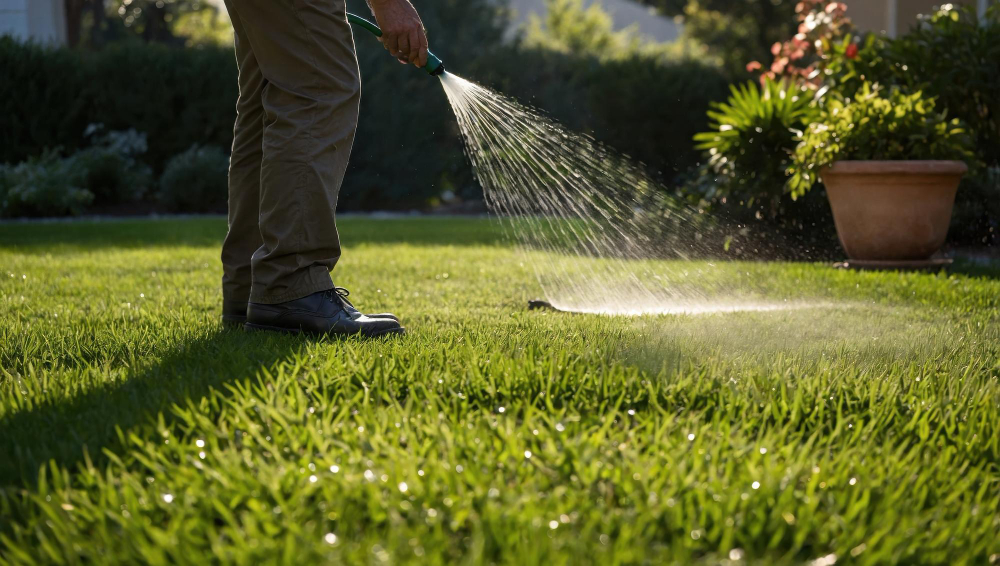- Lawn Turf
- Artificial
- Soil
- Timber
- Composite Decking
- Paving & Stone
Get In Touch With Our Experts Today!
Give us a Call! - Seed & Fertiliser
- Dressing
- Bark

August 01, 2025 Hosepipe BanSummer TurfTurfTurf AdviceTurf Installation
As summer arrives, so do higher temperatures and lower rainfall. And with climate change leading to more unpredictable weather patterns, heatwaves are becoming a regular sight in the UK. Which means, more hosepipe bans.
Although they can be frustrating, hosepipe bans are introduced in certain regions for good reason. They are often temporary restrictions to help preserve water during dry spells. However, when water is critical for turf health, what impact does this ban have on your grass? Especially for landscapers and homeowners rolling out new summer lawns. This article shares everything you need to know about hosepipe bans, and how to keep your lawn hydrated during them.
A hosepipe ban, or a Temporary Use Ban (TUB) if you want to use the official term, is a restriction on the use of water issued by your local water authority. As hosepipes can use large quantities of water, localised bans on using your hose to water your garden, grass, or even to refill paddle pools are introduced. Although you can use other resources to water your garden, you may be fined during this time if you use your hose.
Bans on using a hosepipe are typically enforced during prolonged periods of drought, when reservoir levels are low, or when water demand is high, especially during heatwaves. The aim of a hosepipe ban is to reduce non-essential water usage and conserve water for essential purposes, such as drinking, washing, and sanitation.
Rules are usually outlined by the local authority introducing the ban. However, activities typically prohibited during a hosepipe ban include:
Currently, breaking the rules of a hosepipe ban can result in a fine of up to £1,000. But there are exceptions, especially if you’re a professional landscaper or have just laid new turf.
Hosepipe bans are issued by the relevant water company and local authority in your area. For example, Thames Water, Southern Water, South East Water and Yorkshire Water. They also outline the guidelines, exceptions and timeframe of the ban. Check who supplies your water, and they will have all the information you need regarding hosepipe bans in your area.
If you’re laying new turf or grass seed during a hosepipe ban, there’s good news! Most authorities acknowledge the importance of water for the successful growth and establishment of new turf. It not only hydrates the grass but also reduces turf stress, protects it from heat, and encourages a strong root system, which enables the turf to settle into its new home.
This exception is also known as the 28-day rule. It applies to new lawns, whether seeded or turfed, so they can continue to be watered during the first 28 days following installation. Water can only be used on the grass area, but nowhere else within your garden.
After the 28 days, you must stop using your hose, but you can keep watering with a watering can or irrigation system. We recommend checking your local water company’s guidelines during a hosepipe ban.
For everyone outside the 28-day rule, there are still plenty of ways to keep your lawn hydrated and healthy during a hosepipe ban. Here are our top seven recommendations to reduce water usage and care for your lawn:
You’ve probably heard this one before, but that’s because it works! When watering is allowed, aim to water your lawn early or late in the day. This is when evaporation levels are lower, allowing your grass to absorb as much moisture as possible.
Mulch is comprised of broken-down organic matter. It’s full of natural goodness, nutrients and water – all vital ingredients for your plants and turf. Add a thin layer to the edges of your lawn to help retain the moisture.
Avoid mowing your lawn during a hosepipe ban, or mow at a higher setting to keep the grass blades tall. Taller blades provide shade to soil and grass roots, reducing evaporation levels and helping them retain moisture.
If you don’t already own a water butt, this is a good investment for next summer. A water butt collects and stores rainwater, which you can use throughout the year and especially during a hosepipe ban. And with the rain we receive in the UK, you’re guaranteed a full tank!
Wetting agents are designed to reduce water tension and enhance water absorption into the soil. They help water penetrate and spread more easily, so when you water your lawn, or it rains, your soil can effectively absorb the moisture it needs.
If you’ve filled up a bowl of water but only washed a few items, wait for it to cool and use it to water your lawn. However, be mindful of how dirty the water is, and if you’ve added washing-up liquid with harsh chemicals, don’t use it on your lawn.
Aerating involves spiking holes into your lawn to break up compacted soil and increase airflow. It also helps nutrients and water fully absorb into the soil, reaching the grass roots. By aerating your lawn, you ensure your lawn will be watered deeply when the ban is lifted.
If you are laying a new lawn in the summer, here’s our advice to help give your turf the best chance to establish, producing vibrant, strong and healthy grass:
As turf suppliers, we know more than anyone how frustrating a hosepipe ban can be. We also recognise the importance of these measures in protecting our water supply and ensuring there’s sufficient water for vital resources. If you’re a homeowner or landscaper and need further advice on how to lay and care for your turf during a hosepipe ban, get in touch with our knowledgeable customer service team.
CALL US NOW ON 01234 818 253